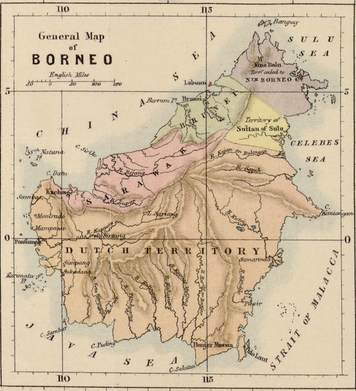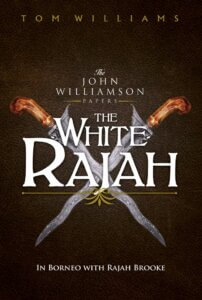This week’s blog marks the anniversary of another massacre. Sorry about that. This one was on 31 July 1849 and, yet again, was a result of the clash of cultures when Europeans began to rule countries in the Far East. In this case, it wasn’t technically colonialism because this happened in Sarawak (in Borneo) where James Brooke ruled in his own right, having been gifted control of the territory by the Sultan of Brunei. Brooke was far from your regular colonialist. He seems to have been motivated largely by a desire to improve the lot of “his” people. Far from making money by exploiting the country, he lost money hand over fist and had to be bailed out by Angela Burdett-Coutts of the famous banking family. His motives were of the very highest. So how did he come to be associated with a massacre so bloody that, even in a time when the deaths of quite a few “natives” in distant parts of the world were regarded as just one of those things, the massacre at Beting Marau resulted in questions in the British Parliament?

The native population of Sarawak was Dyaks. The Dyaks of Sarawak were preyed upon by pirates. (That’s a pirate boat at the top of the page.) The pirates were not individual pirate captains attacking the odd coastal village, but organised tribes who penetrated far upriver and systematically looted Brooke’s subjects. (Think Vikings.) Brooke decided that he had to take firm action against the pirates and involved the British Navy. The local Naval commander was a man called Henry Keppel, who thought that a successful expedition extirpating piracy in the region would do his career no harm. (He was right – it didn’t.) It’s not at all clear that Keppel had the authority to engage in actions on behalf of Sarawak, which was not even technically British, but he pointed out that the pirates had been known to attack other shipping and that he was therefore acting within his mandate to police the South China Seas, where British trade was increasingly important.
Keppel visited Sarawak several times, destroying rebel villages and sinking their boats, but piracy continued to be a problem. In the end it was decided to mount a major attack on the main pirate base at Beting Marau. Remember that these pirates were not Long John Silver and a few renegades but entire tribes for whom piracy was a way of life. Their base was a village where the whole tribe lived – women and children as well as men of fighting age.
By now Keppel was elsewhere but the new naval commander, Sir Francis Collier, agreed (somewhat reluctantly) to go ahead with an attack on Beting Marau. The campaign that was to culminate in the destruction of the pirate stronghold was a significant effort involving British naval forces, including a steamer, and Brooke’s own Dyaks who had scores to settle with the pirates. Here is an illustration of the assembled fleet:

The fleet had to fight their way up the River, passing several smaller forts on their way to the pirates main village. Once at Beting Marau they started their attack with rocket fire and pursued the enemy with overwhelming force.

Before the attack from the water, Brooks own Dyaks had landed downstream and circled round into the jungle behind Beting Marau. As the pirates and their families fled from the naval assault they ran straight into the enemy hidden in the jungle.
The British claimed that several thousand Dyaks had engaged in battle. The British lost 29 killed and 56 wounded. Nobody knows how many Dyaks died – probably over 1000, including many non-combatants, or what we would now call collateral damage. When you fire rockets into buildings made of wood and thatched with leaves you tend to get a lot of that. When news of the massacre reached England there were protests in Parliament.
There was eventually an enquiry, which established that large-scale piracy was a real danger to both British and native shipping in the area and the Royal Navy therefore acted properly in moving against the pirates to prevent this danger. The Dyaks at Beting Marau were armed and resisting the Navy, so the massacre was, by the standards of the day, a justified military action. Even so, there will have been many who agreed with Richard Cobden, the Radical leader, that this was “a slaughter unparalleled in its character since the massacre of the feeble Mexicans by the Spaniards in the 16th century”.

The White Rajah
How did somebody with such good intentions, who had brought peace and a measure of prosperity to Sarawak, end up responsible (because he really was responsible) for a massacre which, if not on the genocidal scale of the Conquistadores, was certainly quite shocking? That’s the question I set out to answer in The White Rajah. In my book, Brooke is clear about the moral justifiability of the attack. The Dyaks of Sarawak are able to live in peace with the systematic looting of the pirates finally put an end to. His lover, though, is appalled by the massacre and leaves Brooke, unable to live with what they have seen. Neither of them is clearly right, or clearly wrong. Real life (even as reflected in novels) turns out to have no right answers.
The White Rajah is available on Amazon in paperback or as an e-book.

